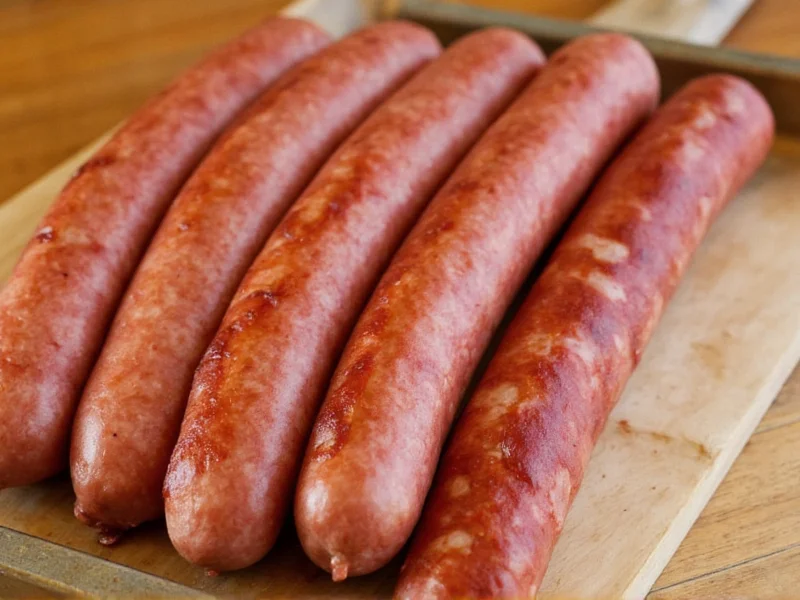Essential Equipment for Perfect Smoked Sausage
Creating authentic smoked sausage requires specific equipment to ensure food safety and optimal results. You'll need a meat grinder with sausage stuffing attachment, a reliable smoker capable of maintaining consistent temperatures, meat trays with parchment paper, digital meat thermometers (both instant-read and leave-in probe types), and food-safe sausage casings (natural hog casings work best for traditional texture). Don't attempt this recipe without proper temperature monitoring equipment—precise temperature control separates successful smoked sausage from potentially unsafe results.
Ingredients for Authentic Smoked Sausage
Quality ingredients make the difference between ordinary and exceptional smoked sausage. For approximately 5 pounds of finished product:
| Ingredient | Measurement | Notes |
|---|---|---|
| Pork shoulder (Boston butt) | 4 lbs | 70% lean, 30% fat ratio is crucial |
| Beef chuck or brisket | 1 lb | Adds depth of flavor |
| Non-iodized salt | 3 tbsp | Iodine affects flavor |
| Garlic powder | 2 tbsp | Fresh garlic burns during smoking |
| Paprika | 2 tbsp | Use Hungarian sweet paprika |
| Black pepper | 1.5 tbsp | Freshly ground preferred |
| Red pepper flakes | 1 tsp | Optional for heat |
| Curing salt (Prague Powder #1) | 1 tsp | Essential for food safety |
| Ice water | 1 cup | Maintains proper temperature |
| Natural hog casings | 5-6 ft | Pre-rinsed and soaked |
Step-by-Step Preparation Process
Begin by cubing your meats into 1-inch pieces and chilling them thoroughly—meat must be cold (below 35°F) before grinding to prevent fat smearing. Combine all dry ingredients thoroughly before adding to the meat. When grinding, use the coarsest plate available (8-10mm) and feed meat steadily while adding ice water gradually to maintain temperature below 40°F throughout mixing. Overworking the meat causes poor texture, so mix just until ingredients are incorporated and the mixture becomes slightly sticky (about 3-4 minutes).
Stuff the sausage mixture into prepared casings using steady, even pressure to avoid air pockets. Twist into 6-inch links, being careful not to overstuff—sausages should feel firm but not tight. Prick any visible air bubbles with a sterilized needle. Refrigerate the sausages uncovered for 12-24 hours to develop flavor and allow casings to dry, which improves smoke adhesion.
Mastering the Smoking Process
Proper smoking technique transforms your sausage preparation into authentic smoked sausage. Start with a clean smoker and preheat to 225°F using indirect heat. For traditional flavor, use a combination of hickory (70%) and applewood (30%)—avoid strong woods like mesquite which overpower sausage flavors. Place sausages on the smoker grate with space between them for air circulation.
The smoking process occurs in two critical phases:
- Smoke absorption phase: Maintain 180-200°F for 1-2 hours until sausages develop a deep pink smoke ring and golden-brown exterior
- Cooking phase: Increase temperature to 225-240°F until internal temperature reaches 160°F (use an instant-read thermometer inserted sideways through the casing)
Never rush the process—smoking at too high a temperature causes fat to render prematurely, resulting in dry, crumbly sausage. The entire process typically takes 3-4 hours depending on sausage thickness and smoker conditions.
Food Safety Considerations for Smoked Sausage
Smoking meat requires strict adherence to food safety protocols. Curing salt (Prague Powder #1) is non-negotiable—it prevents botulism and gives smoked sausage its characteristic color and flavor. Always maintain meat temperatures below 40°F during preparation and ensure sausages reach 160°F internal temperature during smoking. Never partially smoke sausage and finish later, as this creates dangerous temperature zones where bacteria thrive. After smoking, cool sausages rapidly by placing them in an ice bath until the internal temperature drops below 70°F before refrigerating.
Serving and Storage Recommendations
For best flavor, allow smoked sausage to rest in the refrigerator for 24 hours before cooking—this lets flavors fully develop. When ready to serve, grill over medium heat until browned and heated through, or slice and add to traditional dishes like gumbo, red beans and rice, or breakfast hash. Properly smoked sausage will keep refrigerated for 7 days or frozen for up to 3 months. When freezing, vacuum-seal portions with minimal air exposure to prevent freezer burn.
Troubleshooting Common Smoked Sausage Issues
Even experienced sausage makers encounter challenges. If your sausage turns out dry, you likely used meat with insufficient fat content or smoked at too high a temperature. For crumbly texture, the meat was probably too warm during mixing, causing fat smearing. If smoke flavor is too strong, reduce smoking time during the initial phase or use milder woods. When casings split during smoking, this indicates overstuffing or temperature fluctuations—maintain consistent smoker temperatures and don't overfill casings. For uneven color, rotate sausages periodically during smoking to ensure even exposure.
Delicious Smoked Sausage Variations
Once you've mastered the basic smoked sausage recipe, experiment with these authentic variations:
- Andouille style: Add 2 tablespoons cayenne pepper and 1 tablespoon thyme for Louisiana-style heat
- Breakfast sausage: Replace paprika with 2 tablespoons maple syrup and 1 tablespoon sage
- Bratwurst variation: Use all pork and add 1 tablespoon caraway seeds plus 1 teaspoon marjoram
- Hot link style: Increase red pepper flakes to 2 tablespoons and add 1 tablespoon crushed red pepper











 浙公网安备
33010002000092号
浙公网安备
33010002000092号 浙B2-20120091-4
浙B2-20120091-4